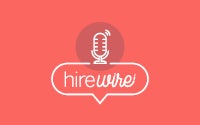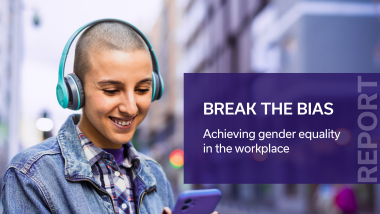3 ways to create a more gender inclusive culture
In our post-pandemic landscape, gender equality has been left in a vulnerable position.
The Covid-19 pandemic disproportionally affected women’s employment globally: across Europe, women have experienced 1.8 times more job losses than men. In the U.S., women lost 5.4 million jobs during the recession – nearly one million more job losses than men. In March 2021, the percentage of women in or looking for work in the US was at 57.4% – the lowest it had been since December 1988. As companies worldwide work towards correcting this imbalance and getting their gender equality goals back on track, it's clear that inclusion in the workplace has never been so important.
Creating a more supportive and inclusive workplace for women begins with recognising that the onus isn’t on them to alter their behaviours to achieve gender equality – it’s the institutions, systems and structures around them that need to change. Here are some powerful actions that every organisation can take to promote gender inclusion and alleviate bias within their company culture.
Employ people analytics
HR decisions based on instinct and intuition alone rarely align with the reality of what your organisation needs. This approach can leave your workforce susceptible to unconscious bias and discrimination. People analytics is the practice of gathering and using employee data to make smarter and more informed decisions – from who to hire, to who gets the most visible projects and facetime with clients. More than 70% of companies consider people analytics to be a high priority.
While there are many people analytics tools available on the market, platforms such as RSIntelligence take a culture-focused approach and can help you create a more inclusive workplace environment. Using software to track gender bias at each stage of decision-making processes helps organisations identify issues and understand which programmes need to be implemented in order to address them.
For example, a study by AIHR collected and examined tens of thousands of high-quality data points – included surveys, one-on-one employee-manager check-ins, and goalsetting tools – at five medium-sized U.S. and international companies. The results uncovered significant inequalities between the male and female employees: although they were equally as likely to meet goals, men were getting 25% more positive evaluations compared to women in the same position. Equipped with tangible data, people analytics puts HR teams in a better position to make meaningful change.
Review your processes
45% of women believe gender stereotypes embedded in the recruitment process are the biggest barrier to increasing the number of experienced female talent. One way companies can address this – along with many other forms of bias and discrimination – is by reviewing their hiring processes, including every stage and candidate touchpoint. Resource Solutions’s award-winning Recruitment Inclusivity Audit analyses the impact of recruitment processes through eight different Diversity & Inclusion lenses – including Gender, Ethnicity, Disability & Neurodiversity, LGBTQ+, Age, Socio-Economic, Faith, and Parental & Caregiving – across 12 stages of the candidate journey.
For example, informal shortlists are a common recruitment practice. When a hiring manager hears about a role vacancy, they may instinctively start building a list of viable candidates, most likely to be individuals they have forged relationships with over the years in educational and professional settings. These candidates receive strong consideration before the job ad has even been published, and intentionally or not, they will often receive preferential treatment compared to those who did not appear on the informal list. The problem with these informal shortlists is that if the role in question is a male-dominated one, the hiring manager may find that male candidates come to mind first, simply because they associate men with those types of roles.
A series of studies by Harvard Business Review sought out a simple way to create a more inclusive recruitment process. Their theory was that hiring teams can alleviate gender bias from informal shortlists by expanding them. In one study, participants were asked to imagine themselves as a filmmaker looking to recruit a lead actor for their upcoming action-thriller film and were tasked with providing an informal shortlist featuring three potential candidates. Subsequently, they asked to add three additional names to their existing list. The study revealed that the number of female candidates increased by 33% in the expanded shortlist compared to the initial shortlist. Even small adjustments such as these can have an important impact.
Recognise the importance of role models
It is human nature to feel inspired to pursue a particular path when we see people like ourselves successfully doing the same thing. In the workplace, women simply don’t have the same of number of senior role models as their male colleagues, and as a result, they may feel less able to visualise themselves in a senior position. In 2021, the proportion of women in senior management roles globally grew to 31%, the highest number ever recorded. While this development is promising, a recent study by Mercer of over 1,100 organisations worldwide suggests that the higher up the business you go, the fewer women there are to be found. According to their research, women accounted for 37% of managers, but only 23% of executives.
The lack of representation for women in senior positions sends negative messages to both male and female employees around a woman’s potential path within the organisation. In addition to appointing women in the senior roles they deserve and will flourish in, companies should use female role models as an opportunity to challenge traditional viewpoints and unconscious biases among their workforce, such as the idea that those working flexible hours are less ambitious or motivated. According to a survey by Promundo of adults aged 25 to 45, 60% of men support more female leadership in their workplace. This bedrock of support among men should further incentivise companies to promote women and further normalise the concept of female leaders, which will only lead to more widespread acceptance.
Download our whitepaper, Break the Bias: Achieving gender equality in the workplace, for further insights into gender equality and to discover how to foster a more inclusive company culture. Alternatively, speak to one of our Diverse Hiring Practitioners to discuss your workforce diversity needs here.













